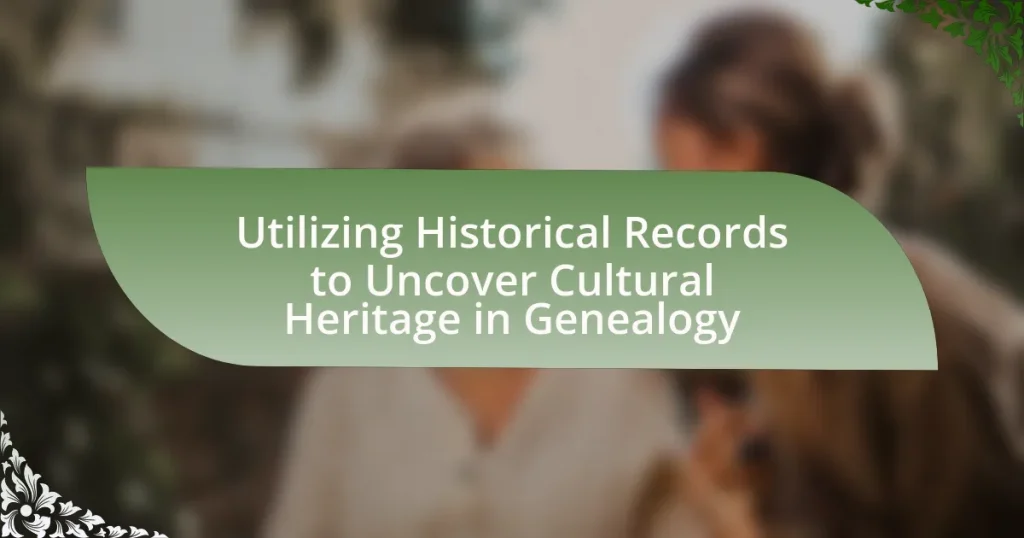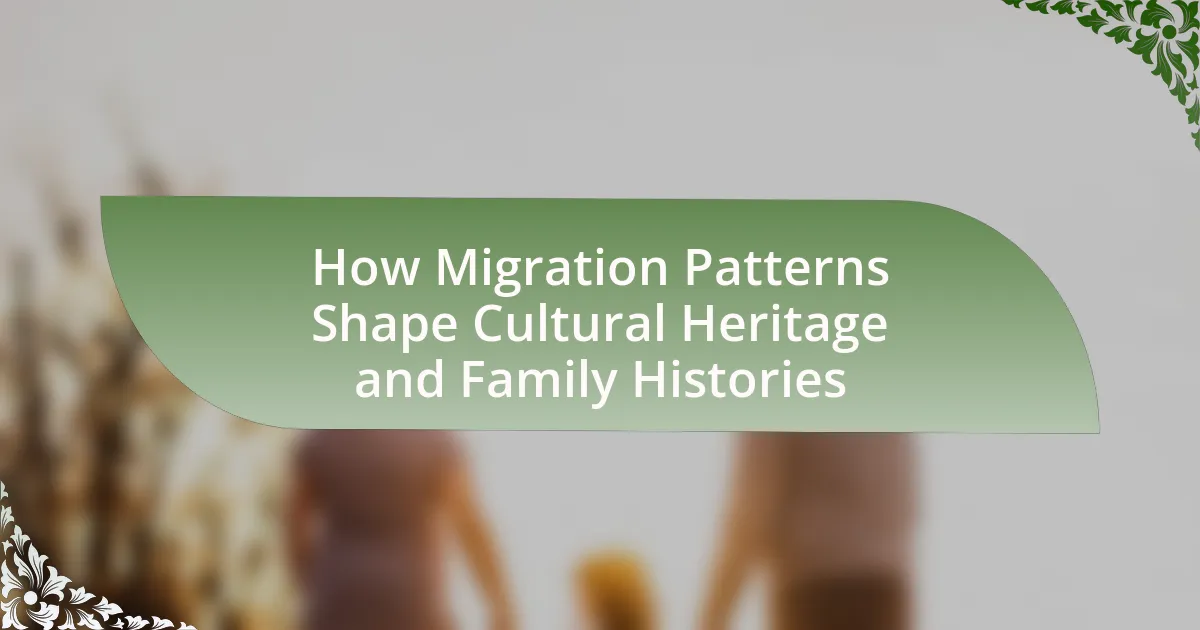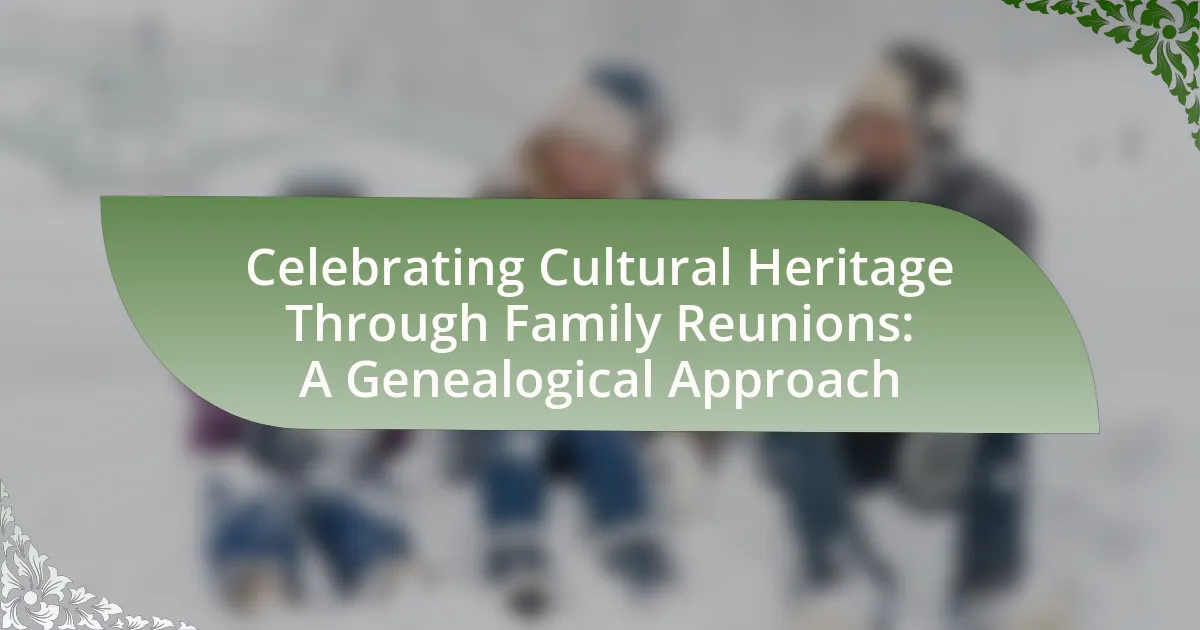The article focuses on the significance of historical records in genealogy and their role in uncovering cultural heritage. It outlines various types of historical records, such as vital records, census data, and immigration documents, which provide essential information for tracing ancestry and understanding familial connections. The discussion includes methods for accessing these records, the challenges faced in genealogical research, and best practices for ensuring accuracy. Additionally, the article emphasizes how analyzing historical records can reveal cultural practices, migration patterns, and social customs, ultimately enhancing the understanding of individual and collective cultural identities.
What are Historical Records and Their Importance in Genealogy?
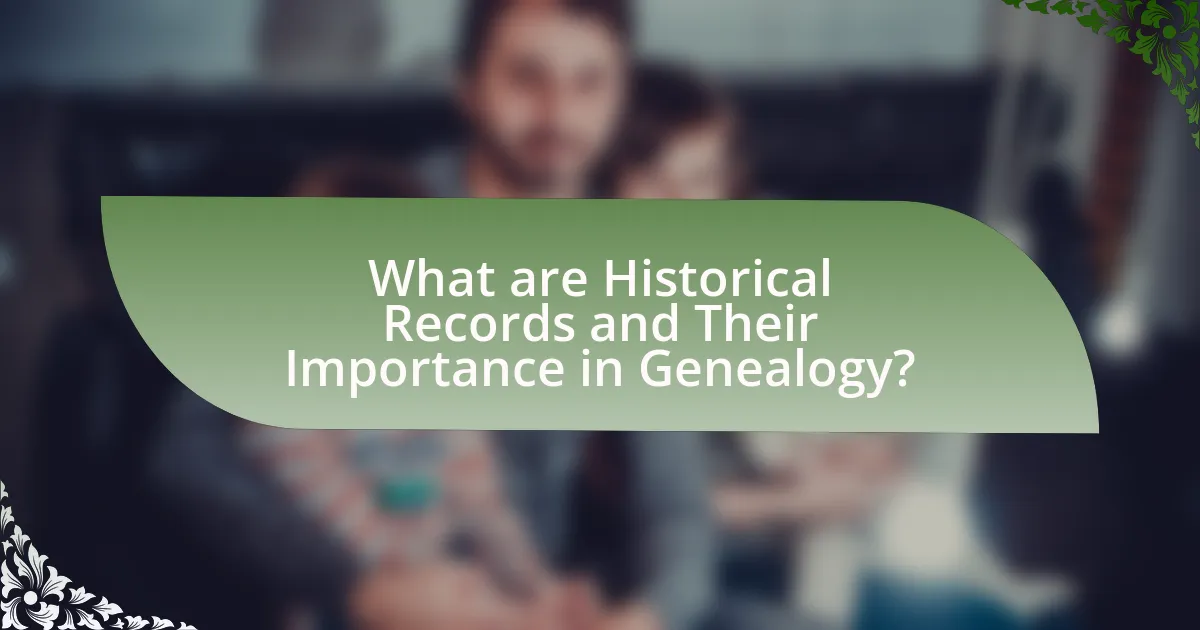
Historical records are documents that provide evidence of past events, people, and places, and they play a crucial role in genealogy by helping individuals trace their ancestry and understand their family history. These records include birth, marriage, and death certificates, census data, immigration records, and land deeds, which collectively offer insights into familial connections and historical contexts. The importance of historical records in genealogy lies in their ability to establish lineage, verify relationships, and uncover cultural heritage, enabling researchers to construct accurate family trees and gain a deeper understanding of their ancestors’ lives and experiences.
How do historical records contribute to understanding cultural heritage?
Historical records significantly enhance the understanding of cultural heritage by providing documented evidence of past societies, traditions, and practices. These records, such as birth and marriage certificates, census data, and land deeds, offer insights into the social structures, migration patterns, and daily lives of individuals and communities. For instance, the 1940 U.S. Census reveals demographic shifts and settlement patterns that reflect broader cultural trends, illustrating how communities evolved over time. By analyzing these records, researchers can trace lineage, uncover ancestral connections, and appreciate the diverse influences that shape cultural identities.
What types of historical records are most relevant to genealogy?
The types of historical records most relevant to genealogy include vital records, census records, military records, immigration and naturalization records, and land and property records. Vital records, such as birth, marriage, and death certificates, provide essential information about individuals and family relationships. Census records offer insights into household compositions and demographic details over time. Military records document service and can reveal family connections through service members. Immigration and naturalization records trace the arrival and citizenship of ancestors, while land and property records can indicate ownership and familial ties. These records collectively form a comprehensive foundation for genealogical research, enabling individuals to construct accurate family histories.
How can historical records reveal cultural practices and traditions?
Historical records can reveal cultural practices and traditions by providing documented evidence of societal norms, rituals, and daily life activities. For instance, census data, religious texts, and legal documents often contain information about family structures, occupations, and community events, which reflect the values and customs of a particular culture. Additionally, records such as marriage licenses and birth certificates can illustrate lineage and inheritance practices, showcasing how cultural traditions are passed down through generations. Historical accounts, like diaries and letters, further enrich our understanding by offering personal insights into the lived experiences of individuals within their cultural contexts.
Why is it essential to utilize historical records in genealogy research?
Utilizing historical records in genealogy research is essential because they provide verifiable evidence of ancestry and familial connections. Historical records, such as birth certificates, marriage licenses, census data, and immigration documents, serve as primary sources that confirm relationships and lineage. For instance, the U.S. Census records, conducted every ten years since 1790, offer detailed information about family members, their ages, and their places of residence, allowing researchers to trace family histories accurately. This reliance on documented evidence ensures that genealogical research is grounded in factual data, enhancing the reliability of family trees and historical narratives.
What insights can be gained from analyzing historical records?
Analyzing historical records provides insights into cultural heritage, lineage, and societal changes over time. These records, such as birth, marriage, and death certificates, reveal familial connections and migration patterns, allowing individuals to trace their ancestry and understand their cultural roots. For instance, census data can illustrate demographic shifts and community structures, while land ownership records can highlight economic status and social mobility within families. Such information not only enriches personal genealogical research but also contributes to a broader understanding of historical contexts and cultural evolution.
How do historical records enhance the accuracy of genealogical research?
Historical records enhance the accuracy of genealogical research by providing verifiable data about individuals and families, such as birth, marriage, and death certificates. These documents serve as primary sources that confirm relationships and timelines, allowing researchers to construct more reliable family trees. For instance, census records can reveal household compositions and migration patterns, while military records may offer insights into ancestors’ service and locations. The use of these records reduces reliance on oral histories, which can be inaccurate, thereby increasing the overall credibility of genealogical findings.
What Methods Can Be Used to Access Historical Records?

To access historical records, individuals can utilize methods such as online databases, archival research, and local repositories. Online databases like Ancestry.com and FamilySearch provide digitized records, making it easier to search for genealogical information. Archival research involves visiting institutions such as national archives or local historical societies, where physical records are stored. Local repositories, including libraries and courthouses, often hold unique documents relevant to specific regions or families. These methods collectively enhance the ability to uncover cultural heritage in genealogy by providing diverse sources of historical data.
How can individuals locate historical records for genealogy?
Individuals can locate historical records for genealogy by accessing online databases, visiting local archives, and utilizing genealogical societies. Online platforms such as Ancestry.com and FamilySearch.org provide extensive collections of digitized records, including census data, birth and death certificates, and immigration records. Local archives often house unique documents, such as land deeds and wills, which can be invaluable for family research. Additionally, genealogical societies frequently offer resources, workshops, and expert guidance to assist individuals in their search for historical records.
What online resources are available for accessing historical records?
Online resources for accessing historical records include websites such as Ancestry.com, FamilySearch.org, and Archives.gov. Ancestry.com offers a vast collection of census records, military records, and immigration records, which are essential for genealogical research. FamilySearch.org, operated by The Church of Jesus Christ of Latter-day Saints, provides free access to a wide range of historical documents, including birth, marriage, and death records. Archives.gov, the National Archives website, offers access to federal records, including military service records and immigration files. These platforms collectively serve as crucial tools for individuals researching their ancestry and cultural heritage.
How can local archives and libraries assist in finding historical records?
Local archives and libraries assist in finding historical records by providing access to a variety of primary sources, including documents, photographs, and manuscripts. These institutions often house unique collections that reflect local history, such as census records, land deeds, and newspapers, which are essential for genealogical research. Additionally, trained staff can offer guidance on navigating these resources effectively, helping researchers locate specific information pertinent to their ancestry. Many archives and libraries also provide online databases and digitized records, expanding access to historical documents beyond physical visits, thereby facilitating easier research for individuals seeking to uncover their cultural heritage.
What challenges might arise when utilizing historical records?
Challenges that might arise when utilizing historical records include issues of accuracy, accessibility, and interpretation. Historical records may contain errors due to transcription mistakes, biases of the record keepers, or incomplete information, which can lead to misinterpretations of genealogical data. Additionally, many historical records are not digitized or are stored in locations that are difficult to access, limiting researchers’ ability to obtain necessary information. Furthermore, the context in which records were created can vary significantly, making it challenging to interpret them correctly without understanding the cultural and historical background. These factors can complicate the process of uncovering cultural heritage in genealogy.
How can researchers overcome issues related to record accessibility?
Researchers can overcome issues related to record accessibility by utilizing digital archives and collaborative platforms. Digital archives, such as the National Archives or Ancestry.com, provide online access to historical records, allowing researchers to bypass physical limitations. Collaborative platforms, like WikiTree, enable researchers to share findings and resources, enhancing collective access to genealogical data. A study by the Pew Research Center indicates that 56% of Americans have used online resources for genealogy, highlighting the effectiveness of digital tools in improving record accessibility.
What are common pitfalls in interpreting historical records?
Common pitfalls in interpreting historical records include contextual misinterpretation, bias in sources, and anachronism. Contextual misinterpretation occurs when historians fail to consider the social, political, and cultural environment of the time, leading to skewed understandings of events. Bias in sources arises when records reflect the perspectives of specific groups, often marginalizing others, which can distort the overall narrative. Anachronism happens when modern values or concepts are applied to historical events or figures, resulting in misleading conclusions. These pitfalls can significantly affect the accuracy of genealogical research and the understanding of cultural heritage.
How Do Historical Records Reflect Cultural Heritage in Genealogy?
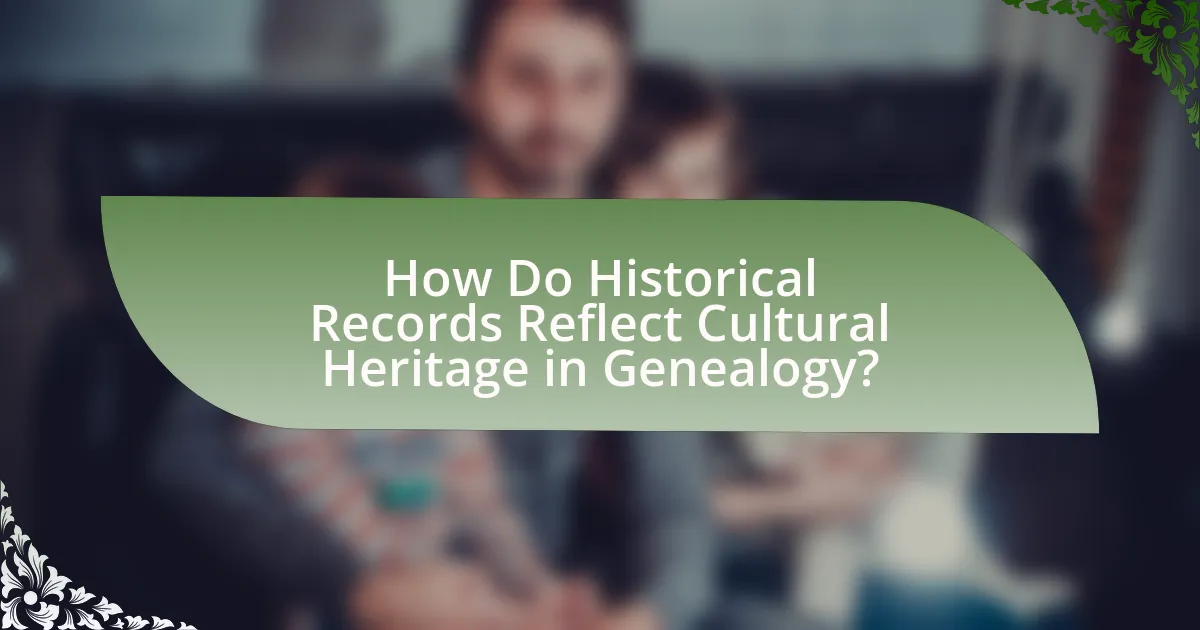
Historical records reflect cultural heritage in genealogy by providing documented evidence of ancestry, migration patterns, and social customs. These records, such as birth, marriage, and death certificates, census data, and immigration documents, reveal the historical context of families and communities, showcasing traditions, languages, and practices that define cultural identity. For instance, census records can indicate the ethnic composition of a community, while immigration records may highlight the origins of families and their cultural backgrounds. This information allows genealogists to trace lineage and understand the cultural influences that shaped their ancestors’ lives, thereby preserving and honoring cultural heritage.
What role do historical records play in tracing cultural lineage?
Historical records are essential for tracing cultural lineage as they provide documented evidence of ancestry, migration patterns, and social structures. These records, including birth, marriage, and death certificates, census data, and immigration documents, offer concrete details about individuals and families, allowing researchers to construct accurate family trees and understand cultural heritage. For instance, the U.S. Census records from 1790 to 2020 reveal demographic changes and migration trends that are crucial for understanding the lineage of various cultural groups in America.
How can historical records illustrate migration patterns and cultural exchanges?
Historical records illustrate migration patterns and cultural exchanges by providing documented evidence of population movements and interactions between different cultural groups. For instance, census data, immigration records, and ship manifests reveal the routes taken by migrants and the demographics of communities over time. Additionally, historical documents such as letters, diaries, and official correspondence can highlight the cultural influences exchanged between groups, showcasing how languages, traditions, and practices were shared and adapted. Specific examples include the migration of Irish immigrants to the United States in the 19th century, which is well-documented through passenger lists and census records, illustrating not only the movement of people but also the subsequent cultural integration and influence on American society.
What specific cultural elements can be identified through historical records?
Specific cultural elements identifiable through historical records include language, religious practices, social customs, and artistic expressions. Historical documents such as census records, church registries, and legal texts provide insights into the languages spoken within communities, revealing linguistic diversity and evolution. Religious texts and records illustrate the belief systems and rituals practiced, showcasing the significance of faith in daily life. Social customs, including marriage and burial practices, are documented in various records, reflecting societal norms and values. Additionally, artistic expressions, such as folk art and music, can be traced through historical accounts, highlighting cultural creativity and heritage. These elements collectively contribute to a comprehensive understanding of cultural identity as evidenced by specific historical documentation.
How can genealogists effectively analyze historical records for cultural insights?
Genealogists can effectively analyze historical records for cultural insights by employing a systematic approach that includes contextualizing the records, identifying patterns, and cross-referencing multiple sources. This method allows genealogists to understand the social, economic, and cultural backgrounds of their ancestors, which can reveal significant insights into their heritage. For instance, analyzing census data alongside immigration records can highlight migration patterns and community structures, while examining land deeds may provide information about economic status and land use practices. Such analyses are supported by historical methodologies that emphasize the importance of context in understanding the significance of records, as demonstrated in works like “The Genealogist’s Guide to Historical Research” by Elizabeth Shown Mills, which outlines techniques for interpreting records within their historical frameworks.
What techniques can be employed to extract cultural information from records?
Techniques to extract cultural information from records include qualitative analysis, quantitative analysis, and contextual research. Qualitative analysis involves examining narratives, descriptions, and personal accounts within records to understand cultural practices and beliefs. Quantitative analysis utilizes statistical methods to analyze demographic data, migration patterns, and social structures, revealing insights into cultural trends. Contextual research places records within historical, geographical, and social contexts, enhancing understanding of cultural significance. These methods collectively enable researchers to uncover rich cultural heritage embedded in genealogical records.
How can collaboration with cultural historians enhance genealogical research?
Collaboration with cultural historians can significantly enhance genealogical research by providing deeper contextual understanding of historical events and cultural practices that shaped family histories. Cultural historians possess specialized knowledge about societal norms, migration patterns, and local histories, which can illuminate the circumstances surrounding ancestors’ lives. For example, understanding the impact of the Great Migration on African American families can reveal migration routes and settlement patterns that are crucial for accurate genealogical tracing. Additionally, cultural historians often have access to unique archival materials and oral histories that may not be readily available to genealogists, thereby enriching the research process with diverse perspectives and data sources.
What are best practices for utilizing historical records in genealogy?
The best practices for utilizing historical records in genealogy include thorough documentation, cross-referencing multiple sources, and maintaining organized records. Thorough documentation ensures that all findings are accurately recorded, which is crucial for verifying lineage. Cross-referencing multiple sources, such as census records, birth and death certificates, and immigration documents, enhances the reliability of the information gathered. Maintaining organized records, whether digitally or physically, allows for easier access and review of data, facilitating the research process. These practices are supported by genealogical standards established by organizations like the Board for Certification of Genealogists, which emphasize the importance of accuracy and reliability in genealogical research.
How can genealogists ensure the accuracy of their findings from historical records?
Genealogists can ensure the accuracy of their findings from historical records by cross-referencing multiple sources. This method involves comparing information from various records such as census data, birth and death certificates, and immigration documents to identify discrepancies and confirm details. For instance, if a genealogist finds a birth record that lists a different name than what appears on a marriage certificate, they can investigate further by checking additional records like church registries or military service documents. This triangulation of data helps to validate the information and reduces the likelihood of errors. Furthermore, genealogists should consider the context of the records, including the time period and location, as these factors can influence the accuracy of the information recorded.
What strategies can be used to document and share cultural heritage discoveries?
To document and share cultural heritage discoveries, researchers can employ strategies such as digital archiving, community engagement, and collaborative platforms. Digital archiving involves creating online repositories where artifacts, documents, and findings can be stored and accessed by a global audience, enhancing visibility and preservation. Community engagement encourages local populations to participate in the documentation process, ensuring that cultural narratives are accurately represented and maintained. Collaborative platforms, such as social media and specialized websites, facilitate the sharing of discoveries among scholars, enthusiasts, and the public, fostering a collective understanding of cultural heritage. These strategies are supported by the increasing availability of digital tools and the growing emphasis on participatory research in cultural heritage studies.
